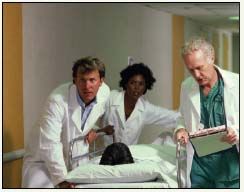Europe lacks consistent emergency radiology subspecialty training
European radiologists should have specialist training in emergency radiology, just as happens in the U.S., delegates were told at ECR 2010 in Vienna.
European radiologists should have specialist training in emergency radiology, just as happens in the U.S., delegates were told at ECR 2010 in Vienna.
The thorny issue of subspecialty training came up during a packed special focus session on imaging the polytrauma patient. In a straw poll conducted by moderator Dr. András Palkó, approximately two-thirds of audience members indicated that radiologists were included in their hospital’s trauma team. However, just a few delegates raised their hands when asked if they had access to training in emergency imaging.

“My generation trained along modalities. This then shifted to training in an organ-based manner and now we speak about abdominal radiologists and chest radiologists. But in the last few years we have recognized that we may want to have a third approach, the diagnosis- or the patient-based approach, and I am speaking here of oncologic imaging and emergency imaging,” said Palkó, a radiologist at the University of Szeged in Hungary. “This may require a kind of subspecialty training not only in the training period for residents, but also in the postgraduate specialization phase.”
The need for dedicated training in emergency imaging was reinforced by Dr. Gerd Schueller, a radiologist at the Medical University of Vienna. When asked directly by the moderator if this type of subspecialty education should be introduced in European hospitals, his answer was an unequivocal “Yes.”
“Of course emergency radiology is a subspecialty. Of course there are specific findings of trauma. A hemangioma of the liver does not look like a hematoma of the liver. We have to learn the differences,” he said. “It is a very important point. Just as we have special training of the lung in Europe lacks consistent emergency radiology subspecialty training radiology, we should have trauma training. This is not taught well in Europe.”
Schueller explained the radiologist’s role when patients present with multiple severe injuries. The polytrauma patient’s condition will be assessed in the first 60 seconds by an anesthesiologist and surgeon, he said. The radiologist on the trauma team then has four minutes to seek out any life-threatening conditions from plain-film x-rays and a focused assessment with sonography in trauma (FAST) scan.
If the patient can be stabilized, he or she may be moved to an adjacent CT unit for whole-body imaging. This can reveal key causes of hypovolemia and hypoventilation, such as pneumothorax, cerebral injury, pericardial tension, and cervical spine fracture. All imaging should be completed within 30 minutes of the patient arriving in the ER.
Dr. Ulrich Linsenmaier, a radiologist at Ludwig Maximilians University in Munich, Germany, set out the different ways CT scans can be provided in the polytrauma setting. Options include installing a CT scanner adjacent to the ER and fitting a moving gantry so the patient need not be lifted. Alternatively, patients can be brought directly to the imaging room when they are first admitted and all workup carried out on the CT table. This is the preferred solution at Ludwig Maximilians.
The outcome for polytrauma patients is much better if they automatically undergo whole-body CT within 30 minutes of admittance rather than allowing doctors to decide who gets CT and who doesn’t, he said.
A FAST ultrasound scan can be completed in 20 seconds, and can be performed using handheld equipment at the scene of the accident or en route to hospital, according to Dr. Etienne Danse, a radiologist at the Catholic University of Louvain in Belgium.
In unstable patients, a finding of free fluid should be enough to send a patient to the angio suite or the operating room for further, invasive, investigation. Stable patients should proceed to CT, regardless of the FAST findings.
“This is the drawback of ultrasound. If there is no free fluid, it doesn’t mean there is nothing to worry about,” he said.
Note: a version of this article appeared in the 2010 ECR Today newspaper.
GE HealthCare Debuts AI-Powered Cardiac CT Device at ACC Conference
April 1st 2025Featuring enhanced low-dose image quality with motion-free images, the Revolution Vibe CT system reportedly facilitates improved diagnostic clarity for patients with conditions ranging from in-stent restenosis to atrial fibrillation.
The Reading Room Podcast: Current Perspectives on the Updated Appropriate Use Criteria for Brain PET
March 18th 2025In a new podcast, Satoshi Minoshima, M.D., Ph.D., and James Williams, Ph.D., share their insights on the recently updated appropriate use criteria for amyloid PET and tau PET in patients with mild cognitive impairment.